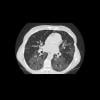ITN Editor Dave Fornell collected numerous examples of how PACS and enterprise imaging vendors are improving the speed and workflow of their systems during booth demonstrations at the 2021 Healthcare Information Management Systems Society (HIMSS). The 11 minute video condenses down the highlights of workflow efficiencies seen during two days o vendor booth tours.
There was a clear trend of many vendors moving to new platforms that leverage more modern cloud-platform interfaces. This enables faster study loading speeds over web connections. These platforms are also using deeper integration of third-party applications and artificial intelligence (AI) software that do not require separate logins or workflows. Read more about these key trends observed at HIMSS 2021.
Vendors also showed various ways they have speed up radiology workflows. These included easier to customize hanging protocols, automated fetching of prior exams, synchronizing views and scrolling between a current a prior exams, use of timeline views of patient priors and procedures to make it easier to find relevant images and reports, and integration of all types of images into one unified viewer.
Specific examples in this video include:
• Visage Imaging: Example of high speed cloud PACS access to 3D mammograms and and priors. This first video clip shows a demonstration of opening large datasets in a matter of a couple seconds over a network connection from a tethered cellphone.
• Visage Imaging: Ability to access multiple modalities on one PACS viewer
• GE Healthcare: Examples of fast access to priors and location on screen
• GE Healthcare: Example of deep integration of third-party AI software
• Siemens: Overview of its Lung AI Pathway Companion workflow
• Change Healthcare: Enabling fast ability to free rotate around lung anatomy rather than going slice by slice manually
• Change Healthcare: Color-coded bar shows loading progress of an image or data set
• Infinitt: Hanging protocol automation to find same view on prior and link for synchronized scrolling
• Infinitt: Use of timeline to get quick view of prior reports and images without needing to open whole exam
• Siemens: Example of deeper integration with third-party apps, in this case Epsilon strain echo analysis
• Fujifilm: Integrated advanced visualization in the radiology workflow for liver segmentation used for surgical or embolization planning
• Fujifilm: Example of life-like cinematic rendering of a CT scan offers new ways to view anatomy and explain it to a patient
• Visage Imaging: Example of enterprise platform able to bring in full original format advanced visualization reconstructed images on a single platform viewer
Related Medical Imaging IT Content From HIMSS 2021:
Advances in CVIS and Enterprise iImaging at HIMSS 21
Photo Gallery of New Technologies at HIMSS 2021
VIDEO: Importance of Body Part Labeling in Enterprise Imaging — Interview with Alex Towbin, M.D.
HIMSS 2021 Showed What to Expect From In-person Healthcare Conferences During the COVID Pandemic
VIDEO: Coordinating Followup for Radiology Incidental Findings — Interview with David Danhauer, M.D.
VIDEO: Cardiology AI Aggregates Patient Data and Enables Interactive Risk Assessments
VIDEO: Examples of COVID-19 CT Scan Analysis Software







































